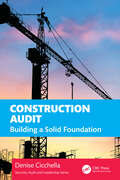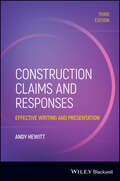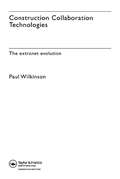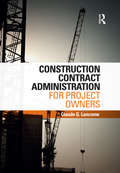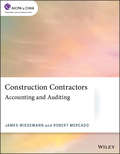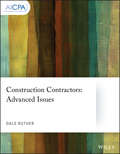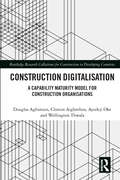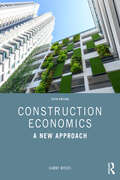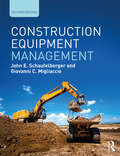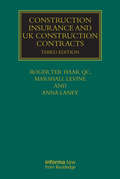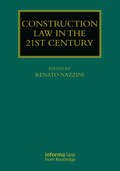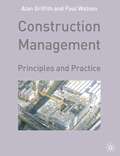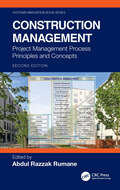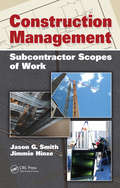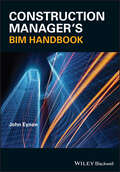- Table View
- List View
Construction Audit: Building a Solid Foundation (ISSN)
by Denise CicchellaConstruction Audit is becoming more and more prevalent, and organizations are appreciating its importance. Learning the basics of construction auditing can provide valuable knowledge and skills for professionals and students in the construction industry, offering insights into financial management, risk mitigation, compliance and overall project oversight.This book is not just for auditors, however. It could be used by project managers, integrity monitors, construction managers and anyone else who wants to understand the elements that go into creating a successful project. Legal teams involved in contracting and overpayment recovery will also benefit.This book: Walks you through all phases of construction, starting with project inception. It will guide the reader through all the processes and the risks in each of these. Will guide the reader through the many challenges they will face throughout the life of the project. This book provides real-life solutions to common problems in construction. Introduces project management techniques; while not concentrating on a special methodology, the book builds on project management fundamentals. Understanding this will help enable the reader to talk to project managers more effectively. Defines the components of a successful project and gives the reader the tools needed to ensure these components. Uses real-life examples of control breakdowns, errors or fraud. Will help readers build an audit strategy and plan by understanding risks and effective controls that can be implemented to mitigate risk. Whether tackling your first project or your 21st project, this book will help you think outside the box and understand the finite processes and pieces of your project. There is always room for something new, new perspectives or improvement, and this book will help you find it.
Construction Business Management: What Every Construction Contractor, Builder And Subcontractor Needs To Know (Rsmeans Ser. #67)
by Nick B. GanawayOnly 43 per cent of U.S. construction firms remain in business after four years. Why? Inadequate management, according to the U.S. Small Business Administration. This is surprising because most construction firms are formed by ambitious construction project managers, executives and tradesmen who have excelled at what they have been doing. But as experienced as these entrepreneurs may be, they are not likely prepared to take on the full range of responsibilities forced on them in managing the business of construction in its entirety.While this business failure rate and its causes are based on U.S. experience, available data from a number of other industrialized countries shows they are similar.This book describes in detail what the business side of the construction equation requires of the construction firm owner. The contractor who quickly learns these requirements can identify and avoid or manage around the pitfalls that cause the high failure rate in our industry and put his or her construction firm on a level playing field with the best-run companies in the business. The detailed duties of the owner, whether in the U.S., U.K., Australia or Canada, are a common theme throughout the book. The author, Nick Ganaway, speaks peer-to-peer, and the book is sprinkled with supporting examples from his own experience. He is immersed in the industry and this book is "based on the things I've learned, used, and refined as a light-commercial general contractor in the course of starting and operating my own construction firm for 25 years." The contractor doing $5 million or $50 million or more in annual sales or the equivalent amount in other countries, or the entrepreneur who is just starting up, can use the tried and proven material in this book to build a business that is profitable, enjoyable, and enduring.Additionally, the book devotes a chapter to specializing in chain-store construction.
Construction Claims and Responses: Effective Writing and Presentation
by Andy HewittThe latest and most up-to-date edition of the best hands-on guide to construction claims and claims response preparation In the newly revised third edition of Construction Claims and Responses: Effective Writing and Presentation, renowned construction claims and disputes consultant Andy Hewitt delivers yet another authoritative and practical discussion of how to prepare and respond to construction claims. Covering a variety of different types of claims – including variations, extensions of time, and additional payment – the book demonstrates an effective step-by-step process of building up a claim by breaking it down into manageable sections: contract details, causes, effects, entitlement, and quantum. You’ll find worked examples of typical claims, complete with sample wording, as well as updated and simplified examples of responses, additional detail on cost calculations, and updates to material to maintain compliance with FIDIC 2017. Readers will also discover: A thorough introduction to properly constituted and presented claims, including the establishment of contractual entitlement and comprehensive documentationComprehensive explorations of what constitutes sufficient cause and effect for a construction claimRevised and clarified worked examples of commonly made construction claims and responsesComplete discussions of accurate quantum calculations Perfect for all construction project personnel around the world involved in the preparation of construction claims, Construction Claims and Responses will also benefit those preparing responses to such claims, as well as quantity surveyors, contracts managers, project managers, claims consultants, commercial managers, engineers, architects, and adjudicators.
Construction Collaboration Technologies: An Extranet Evolution
by Paul WilkinsonSince the late 1990s, web-based collaboration technologies (‘project extranets’) have become increasingly widely used within the UK construction industry and are now routinely deployed on the design and construction of thousands of projects. The first book dedicated to the topic, this comprehensive guide will help current and future construction professionals understand, implement and use such systems more effectively. Cutting through the hype and jargon, it offers expert advice and guidance from an industry insider on choosing a software provider, key software features, hosting, legal issues, connectivity, achieving user buy-in and assessing the benefits.
Construction Company Management
by Kumar Neeraj Jha Abid Hasan Asheem ShresthaConstruction Company Management will give readers a detailed understanding of the critical aspects of managing a successful construction company in a dynamic and complex construction business environment characterised by intense competition, supply chain disruptions, and rapid changes in technology, regulations, client preferences, and market conditions.The book will introduce readers to different dimensions of construction company management. The topics covered reflect current business practices in the construction industry, including company strategy and business models, stakeholder management, contract management, resource management, risk management, knowledge management, company finance, digital innovation, organisational resilience, and the regulatory environment. The book also includes much-needed discussions on ethics, integrity and professional standards, and diversity, equity, and inclusion in construction companies. It explores the opportunities and challenges relevant to construction company management in global contexts with the help of case studies from different regions of the world.Providing a concise book on this essential subject, Construction Company Management serves both students and those educators who teach it in their built environment courses. Practitioners will find the theory-informed company management practices discussed in the book valuable and useful in their practical contexts.
Construction Contract Administration for Project Owners
by Claude G. LancomeConstruction Contract Administration for Project Owners is aimed at public and private owners of real estate and construction projects. The book is intended to assist owners in their contractual dealings with their designers and their contractors. Most owners are not primarily in the business of designing and building facilities. The fact that their primary business is not design and construction places them at a disadvantage when negotiating, drafting, and administering design agreements and construction contracts because their designers and contractors use these documents every day. This book is intended to assist owners to redress this imbalance by equipping owners to draft and administer contracts so as to protect their interests. The book is aimed at owner personnel with all levels of knowledge in the business of managing projects. It can serve as a comprehensive introduction to drafting and administering design agreements and construction contracts for beginners. For intermediate level personnel, it can serve as a manual to be read to enhance the reader’s skills in this area. For the sophisticated project management professional, it can serve as a resource to be consulted in connection with very specific issues as they arise on a project.
Construction Contractors: Accounting and Auditing (AICPA)
by James Wiedemann Robert MercadoWith construction activity increasing and significant changes to the revenue recognition model, it is more important than ever for accountants and financial managers to be on top of the very latest in accounting and auditing changes for the construction industry. This guide examines the most recent updates and key issues impacting construction accounting and auditing. It covers new changes as a result of FASB ASU 2014-09, it also explores the relationship between the contractor and the surety.
Construction Contractors: Advanced Issues
by Dale RutherConstruction Contractors: Advanced Issues by Dale Ruther
Construction Digitalisation: A Capability Maturity Model for Construction Organisations (Routledge Research Collections for Construction in Developing Countries)
by Clinton Aigbavboa Wellington Thwala Douglas Aghimien Ayodeji OkeThis book explores construction digitalisation, particularly in developing countries. The book conceptualises a digitalisation capability maturity model that will enable construction organisations to self-assess and benchmark their digital capabilities in their quest for digital transformation. Digitalisation offers a significant solution to the age-long problems of the construction industry. Research shows that when construction organisations transform from a traditional service delivery approach to a more digitalised approach, significant improvement in project delivery and better competitive advantage for these organisations will be attained. The attainment of these benefits is evident in developed countries where the digitalisation of construction activities continues apace. Unfortunately, the story is not the same for construction organisations in developing economies. While some organisations might be willing to be digitally transformed, most have no clue how to go about it. To this end, this book provides guidelines for construction organisations seeking to transform their entities digitally. Its content is a valuable read for construction company owners as it provides a model which they can use in the digitalisation of their activities. Also, regulatory bodies in the construction industry can adopt the capabilities identified in the book as essential prerequisites for their members. Furthermore, the book serves as excellent theoretical background reading for management researchers seeking to expand their knowledge on the digitalisation of the construction industry and other associated industries.
Construction Economics: A New Approach
by Danny MyersConstruction Economics provides students with the principles underlying the relationship between economic theory and the construction industry. Its new approach specifically examines the problems of securing sustainable construction. The new edition has been fully revised to provide an overview of the economy and construction markets since the global financial crisis. As such it examines the challenges of changing government policy, adapting to climate change, adopting BIM, and reducing costs. A new introduction along with new readings, data, examples, glossary items, government strategies, and references, revises this established core text and brings it up to the historic EU referendum. As with previous editions, it retains a tried and tested format: a clear and user-friendly style use of a second colour for emphasis regular summaries of key points a glossary of construction economics extensive use of tables and figures extracts from Construction Management and Economics reviews of useful websites. This invaluable textbook is essential reading across a wide range of disciplines from construction management and civil engineering to architecture, property and surveying.
Construction Economics: A New Approach
by Danny MyersConstruction Economics provides students with the principles underlying the relationship between economic theory and the construction industry. Its new approach specifically examines the problems of securing sustainable construction and this fifth edition broadens the message to address the immediacy of the problems relating to the carbon-based world that we have constructed. Embracing the whole process of the construction life cycle, the new edition discusses the economic impact of the Covid pandemic on the industry and the broader implications of the promise to build back better. It also includes new coverage of the opportunities offered by technology, the establishment of higher standards to achieve greater energy efficiency and wellbeing, the adoption of the principles of a circular economy, the retrofit of existing buildings and the recycling of materials. New sections also highlight the methodology of the subject to identify the boundaries of construction economics and clarify what to expect and what can be achieved. As with previous editions, it retains a tried and tested format including: a clear and user-friendly style use of colour for emphasis regular summaries of key points a glossary of key terms extensive use of tables, figures and data readings from Construction Management and Economics tutorial questions to review each section research guidance reviews of useful websites. This invaluable textbook is essential reading across a wide range of disciplines. It provides the economic context to the relevance of sustainability and debates about climate change, highlighting the vital contributions that surveyors, contractors, project managers, engineers, architects and developers can offer to take it forward.
Construction Equipment Management
by John E. Schaufelberger Giovanni C. MigliaccioThis revised and updated edition of Construction Equipment Management fills a gap on this subject by integrating both conceptual and hands-on quantitative knowledge on construction equipment into a process that facilitates student learning. The first six chapters summarize interdisciplinary concepts that are necessary to ground students' learning on construction equipment management, including both engineering and economics. Each of the next 16 chapters covers a different type of construction equipment and associated methods of use. The final chapter introduces the more advanced concept of operation analysis. This allows the book to be used on numerous courses at different levels to prepare graduates to apply skills on construction equipment when planning for a new project, estimating its costs, and monitoring field operations. Organized around the major categories of construction equipment, including both commercial and heavy civil examples, case studies, and exercises, this textbook will help students develop independence in applying concepts to hands-on scenarios. A companion website provides an instructor manual, solutions, additional examples, lecture slides, figures, and diagrams.
Construction Health and Safety in Developing Countries (Spon Research)
by Fidelis Emuze Patrick Manu Tarcisio Abreu Saurin Bonaventura H. W. HadikusumoThe global construction sector is infamous for high levels of injuries, accidents and fatalities, and poor health and well-being of its workforce. While this record appears in both developed and developing countries, the situation is worse in developing countries, where major spending on infrastructure development is expected. There is an urgent need to improve construction health and safety (H&S) in developing countries. The improvement calls for the development of context-specific solutions underpinned by research into challenges and related solutions. This edited volume advances the current understanding of construction H&S in developing countries by revealing context-specific issues and challenges that have hitherto not been well explored in the literature, and applying emergent H&S management approaches and practices in developing countries. Coverage includes countries from the regions of sub-Saharan Africa, Latin America, Asia and Europe. This book, which is the first compendium of research into construction H&S issues in developing countries, adds considerable insight into the field and presents innovative solutions to help address poor H&S in construction in developing nations. It is a must read for all construction professionals, researchers and practitioners interested in construction and occupational H&S, safety management, engineering management and development studies.
Construction Insurance and UK Construction Contracts (Construction Practice Series)
by Roger ter Haar Anna Laney Marshall LevineConstruction Insurance and UK Construction Contracts has long been the premier text for legal professionals looking for a combined analysis of construction contracts and their relation to insurance law. In a new and updated third edition, this book continues to provide in-depth commentary and pragmatic advice on all the most important regulations and policies surrounding contracts and insurance in the construction industry. Including brand new chapters on reinsurance and energy products, this book covers subjects such as: Minor, intermediate and major project construction contracts Classes of insurance contract The role of insurance brokers Risks in construction and legal liability Professional indemnity insurance and directors' and officers' liability insurance Bonds and insurance Latent defect insurance Property insurance Health and Safety and Construction Regulations Contract Insurance FIDIC, JCT and NEC 3 regulations PFI/PPP projects in the UK Dispute resolution This book is a vital reference tool and practical guide for lawyers and in-house counsels involved in the construction industry as well as project managers, quantity surveyors, construction contractors, architects and engineers needing advice from an experienced legal perspective.
Construction Law in the 21st Century (Construction Practice Series)
by Renato NazziniMarking the 35th anniversary of the Centre of Construction Law & Dispute Resolution at King’s College London, this volume brings together a large and illustrious group of contributors to create a comprehensive and authoritative guide cutting across all key areas of contemporary construction law, ranging from construction arbitration to procurement and contract law.It takes an international approach to construction law and considers issues such as investor-State dispute settlement, insolvency and liquidated damages in civil law and common law jurisdictions and procurement from a comparative perspective, as well as certain key common law/English law topics (such as fitness for purpose) that are of relevance to an international audience.The book provides detailed and practical guidance to the legal framework of the construction industry for barristers, solicitors, arbitrators, adjudicators, academics, contract managers, construction consultants and quantity surveyors, among others.
Construction Machines
by Draško Mück Dinko MikulićThis book provides knowledge to professionals on how to model, calculate, and design machinery for construction operations. Carrying out construction works is unthinkable without construction machines. Awareness of role and properties of construction machines is very important for their design, production, application, and maintenance. This book defines the basic characteristics of the main representatives of construction machines for earthworks, bulldozers, loaders, excavators, vibratory rollers, and transport vehicles, truck cranes, telehandlers, and construction trucks. The book presents a step-by-step explanation of the key technical solutions of mobile construction machines in an expert and illustrative manner, with the help of photographic images, schematics, and case studies. The book will be of use to professionals in industry and students in engineering departments.
Construction Management
by Paul Alan Watson GriffithAdditional resources to accompany the book are available at: http://www. blackwellpublishing. com/howarth/ The construction industry is a global, dynamic and innovative industry that delivers buildings and infrastructure for all aspects of commercial and domestic activity. This dynamic and innovative industry is faced with safety challenges on a project by project and day to day basis. Excellence in Health and safety management is therefore a key requirement of construction industry professional practice, and as such its study is a necessary and core component of a wide range of built environment undergraduate degree programmes, either as a distinct discipline or as an embedded component. Construction Safety Management is an accessible, up-to-date text that outlines the principles and practices of construction health and safety management. It is written to support the study of health and safety on professionally accredited undergraduate built environment degree programmes. The text introduces and informs the reader of issues, concepts, legislation and practice pertinent to the sound development of knowledge and practice requisite for effective construction health and safety management. Students on courses ranging from Architecture, Architectural Technology, Building Engineering, Civil Engineering, Construction Management, Project Management and Quantity Surveying will find that each chapter presents clear learning objectives, addresses key issues and concepts and provides for self-assessment of learning. Additional resources to accompany the book are available at: http://www. blackwellpublishing. com/howarth/
Construction Management JumpStart: The Best First Step Toward a Career in Construction Management
by Barbara J. JacksonThe bestselling introduction to the field, updated and expanded Construction Management Jumpstart is the definitive introduction to the field, providing a detailed walkthrough of each stage of a project from the construction manager’s perspective. Authoritative coverage of fundamental concepts and practices clearly delineates the manager’s role, while step-by-step guidance provides valuable instruction for essential management duties. This new third edition has been updated to reflect the field’s current environment and best practices, giving students a highly-relevant introduction to an evolving industry. Three new chapters include insightful discussion of the pre-construction phase, team management, and sustainability; challenging chapter review questions help reinforce important concepts and help translate them to practice. Construction managers work alongside project managers, and use many of the same tried-and-true techniques—but construction managers must also adhere to a vast array of industry-specific standards and regulations. This book helps you build a foundation in critical concepts and practices while tailoring traditional project management techniques to the construction management sphere. Understand essential management roles and responsibilities for each stage of a construction project Learn how to estimate costs, administer contracts, manage operations, monitor performance, assess risks, and more Explore critical concepts in planning and scheduling that help keep projects running on-time and on-budget Discover how Building Information Modeling software is impacting the industry, and how it affects construction management Evolving regulations, advancing technology, and economies in flux all impact the construction industry in a number of ways; management’s job is to clear obstacles to delivery and streamline the project’s completion. To be effective, construction managers must stay up to date on the latest tools and best practices, and have a strong grasp of the fundamentals of the role. Construction Management Jumpstart provides a practical, highly-relevant introduction to the field.
Construction Management JumpStart: The Best First Step Toward a Career in Construction Management
by Barbara J. JacksonNew edition of a bestselling introduction to construction management, offering a walkthrough of each stage of the construction management process Written from the constructor’s perspective, Construction Management JumpStart is the definitive introduction to the field, providing authoritative coverage of all construction management fundamentals and how the latest trends in project delivery methods, technology, and emerging new career opportunities are impacting the construction management profession. Readers will find step-by-step instructions on how to administer contracts, manage job site operations, plan and schedule projects, monitor project performance, manage project quality and safety, assess project risks, and perform other duties essential to the manager’s role. Key foundational information on residential, commercial, heavy civil, industrial, and environmental industry sectors, project players, and professional affiliations is also included. This revised and updated Fourth Edition reflects the field’s current environment and best practices. Two new chapters include insightful discussion on the scope of the industry and business fundamentals for construction entrepreneurs. Several new sections review capital projects, real estate development, preconstruction services, and design-phase management. Review questions at the end of each chapter help reinforce learning, and an instructor companion website offers PowerPoint slides and quizzes by chapter. Construction Management JumpStart covers topics including: Construction contracts, with information on documentation, drawings, project manuals, and contract types including lump-sum, cost-plus-fee, and guaranteed-maximum-pricePre-construction services, including feasibility studies, constructability reviews, conceptual estimating, value engineering, and life-cycle cost analysisProject cost estimation, covering project size and complexity, site location, time of construction, quality of work, market conditions, and different types of estimatesConstruction operations, including quality control, noise, dust, and mud control, environment protections, and cleanup and trash removal The Fourth Edition of Construction Management JumpStart is an ideal textbook for all undergraduate courses teaching construction management. The text is also highly valuable for career changers seeking to transition into the construction industry and professionals in the field seeking to fill gaps in their knowledge base and stay up-to-date on industry developments.
Construction Management: Project Management Process Principles and Concepts (Systems Innovation Book Series)
by Abdul Razzak RumaneManagement process groups along with the processes in the knowledge areas having to do with the principles and concepts used in the development of major construction activities are very important in the overall construction management process. This volume covers the application of these activities that manage the construction project from inception through to the completion of the construction project.Construction Management: Project Management Process Principles and Concepts discusses the five elements of management functions which include planning, organizing, staffing, directing, and controlling, and explains how these activities/elements of management functions can be used in construction projects. Information about strategic planning, operational planning, intermediate planning, and contingency planning, and the steps involved with relevance to construction projections is offered in this volume. The different types of organizational structures, such as simple, functions, divisional, matrix, team-based, network, and modular, with an example organizational chart, are presented. Also covered are staffing processes such as acquisition, roles and responsibilities, assessment, team building, training, and development, along with directing and controlling elements of the management functions. This volume is rounded out with the inclusion of the five types of management processes, such as initiating, planning, executing, monitoring, controlling, and closing, along with applicable knowledge areas based on the PMBOK® methodology.This volume provides significant information and guidelines to construction and project management professionals (owners, designers, consultants, construction managers, project managers, supervisors, contractors, builders, developers, and many others from the construction related industry) involved in construction projects (mainly civil construction projects, commercial A/E projects) and construction related industries.
Construction Management: Quality Tools and Techniques (Systems Innovation Book Series)
by Abdul Razzak RumaneThe application of quality tools and techniques in construction projects has a great influence on the cost-effectiveness results of construction projects and achieving successful project performance. Quality management tools and techniques help in project planning, execution, monitoring, and control of the project and evolve a project management system that makes project deliverables.Construction Management: Quality Tools and Techniques provides the usage and application of various quality tools and techniques in different phases of construction project management focusing on three quality management processes involving the varying aspects of quality. This volume illustrates how important quality is for construction projects and offers an overview of construction projects along with a brief introduction to the different types of projects, the different phases of the life cycle, and the principles. Project Delivery Systems (PDS) along with their organizational relationship, participants, advantages, and disadvantages of each system are included. The book goes on to discuss the qualification of construction managers and the type of management systems and their roles during the different design stages from the beginning through to the handover of the project is also included.This volume provides significant information and guidelines to construction and project management professionals (owners, designers, consultants, construction managers, project managers, supervisors, contractors, builders, developers, and many others from the construction-related industry) involved in construction projects (mainly civil construction projects, commercial-A/E projects) and construction-related industries.
Construction Management: Subcontractor Scopes of Work
by Jason G Smith Jimmie HinzeConstruction projects are usually completed through the efforts of several specialty contractors that enter into performance agreements with the prime contractor. Mistakes, whether made while bidding or when executing a construction project, can be costly for the facility owner, general contractor, or subcontractor. Focused on helping the project team avoid these mistakes and run their projects more efficiently, this book describes how a prime contractor can coordinate the efforts of subcontractors and address common problems that can occur during various stages. Greater understanding of problematic aspects can assure that the full scope of the project is covered without redundancy.
Construction Management: Theory and Practice
by Chris MarchStudents studying construction management and related subjects need to have a broad understanding of the major aspects of controlling the building processes. Operations Management for Construction is one of three textbooks (Business Organisation, Operations Management and Finance Control) written to systematically cover the field. Focusing on construction sites and operations which are challenging to run, Chris March explores issues such as the setting up of the site, the deciding of the methodology of construction, and the sequence of work and resourcing. As changing and increasing regulations affect the way sites are managed, he also considers the issues and methods of successful administering, safety, quality and environment. Finally, the contractor's responsibility to the environment, including relationships with third parties, selection of materials, waste management and sustainability is discussed. Chris March has a wealth of practical experience in the construction industry, as well as considerable experience of teaching, which he uses to support the theory and principles set out in the book.
Construction Manager's BIM Handbook
by John EynonBuilding Information Modelling (BIM) harnesses digital technologies to unlock more efficient methods of designing, creating and maintaining built environment assets, so the Construction Manager's BIM Handbook ensures the reader understands what BIM is, what the UK strategy is and what it means for key roles in the construction team. ensure that all readers understand what BIM and are fully aware of the implications of BIM for them and their organisations provides concise summaries of key aspects of BIM ensure that all readers can begin to adopt this approach in future projects includes industry case studies illustrating the use of BIM on large and small projects
Construction Microeconomics
by Christian BrockmannCONSTRUCTION MICROECONOMICS Unique and comprehensive reference describing microeconomic approaches, theories, and models adapted to and developed for the construction industry Construction Microeconomics provides comprehensive coverage of microeconomics applied to the construction industry, focusing on construction clients, who initiate construction projects, and on contractors who transform the ideas and plans of clients into infrastructure and buildings. With the help of microeconomic theory, it tries to answer questions about decision-making by clients, contractors, and governments with respect to projects in the built environment. It includes discussions of alternative theories to mainstream microeconomics, such as new institutional economics, behavioral economics, and the capability approach. Applications from the construction sector including land supply, sustainability, industrialization, and lean construction are provided to ground the theory in practical construction. In Construction Microeconomics, readers will learn: How microeconomic theory relies heavily on assumptions for modeling and the nuances of adjusting those assumptions How heterogenous contract goods affect supply and demand, markets, information, technology, and accordingly, the theories of contractors and owners How interaction influences the production process and how land as a production factor changes the production function How ex-ante costs determine the cost theory of the contractor and why contracting is more akin to the service sector than the goods sector Advanced undergraduate and masters students, lecturers and academics in construction and related disciplines, and professionals in the construction industry looking for expert analysis into a unique facet of the field will find Construction Microeconomics to be a valuable, complete, and authoritative reference on the subject.
